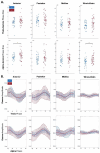This is a preprint.
Altered oscillatory coupling reflects possible inhibitory interneuron dysfunction in Rett syndrome
- PMID: 40778166
- PMCID: PMC12330464
- DOI: 10.1101/2025.07.21.25331927
Altered oscillatory coupling reflects possible inhibitory interneuron dysfunction in Rett syndrome
Abstract
Background: Rett syndrome is a rare neurodevelopmental disorder caused primarily by pathogenic variants in the MECP2 gene, leading to lifelong cognitive impairments. To understand the broad neural disruptions in Rett syndrome, it is essential to examine large-scale brain dynamics at the level of neural oscillations. Phase-amplitude coupling-a form of cross-frequency interaction that supports information integration across temporal and spatial scales-is a promising candidate measure for capturing such widespread neural dysfunction. Phase-amplitude coupling depends on the coordinated activity of specific neuronal subtypes, and while multiple subtypes are implicated in different aspects of the Rett syndrome phenotype, their role in shaping large-scale oscillatory dynamics in Rett syndrome is not well understood. To investigate this, we utilized a multi-level approach, combining EEG recordings with computational modeling to identify alterations in phase-amplitude coupling in Rett syndrome and probe their underlying cellular and circuit-level mechanisms.
Methods: We recorded resting-state EEG from 38 individuals with Rett syndrome and 30 age- and sex-matched typically developing individuals. Phase-amplitude coupling was quantified: modulation index was obtained to determine coupling strength, and phase bias was assessed to examine the preferred phase of coupling. We characterized phase-amplitude coupling across all low and high frequency combinations and electrodes, as well as within canonical theta-gamma and alpha-gamma frequency pairs across four predefined cortical regions. Finally, we modeled a biophysically-constrained Layer 4 cortical network to propose a possible mechanism underlying changes to oscillatory dynamics.
Results: We found significantly stronger phase-amplitude coupling in Rett syndrome across widespread cortical regions and frequency pairs, with a pronounced increase in theta-gamma and alpha-gamma coupling in anterior, posterior, and whole-brain regions (P < 0.05). Individuals with Rett syndrome also exhibited a more positive alpha-gamma phase bias in anterior and whole-brain regions (P < 0.05). Biophysically constrained modelling demonstrated that reduced VIP-expressing interneuron activity alone could recapitulate the pattern of increased theta-gamma and alpha-gamma phase-amplitude coupling observed in Rett syndrome (P < 0.001).
Conclusions: These findings identify alterations in awake-state phase-amplitude coupling in Rett syndrome and propose a mechanistic link to VIP+ interneuron dysfunction. Elevated phase-amplitude coupling may serve as a promising biomarker of cortical dysfunction and a translational bridge from neural circuitry to clinically observable EEG signatures. By implicating VIP+ interneurons, our results open new avenues for testing interventions in preclinical models to identify potential novel therapeutic targets for individuals with Rett syndrome.
Keywords: EEG; Rett syndrome; VIP+ interneurons; neurogenetic disorders; phase-amplitude coupling.
Conflict of interest statement
Dr. Percy has received research support from the NIH and has been a site PI for Acadia Pharmaceuticals. He is a consultant for Acadia Pharmaceuticals, Taysha Gene Therapies, and Neurogene. He has prepared educational materials for WebMD, Medscape, Pharmacy Times Continuing Education, Prime Inc., and the CME Institute.
Figures







Similar articles
-
Prescription of Controlled Substances: Benefits and Risks.2025 Jul 6. In: StatPearls [Internet]. Treasure Island (FL): StatPearls Publishing; 2025 Jan–. 2025 Jul 6. In: StatPearls [Internet]. Treasure Island (FL): StatPearls Publishing; 2025 Jan–. PMID: 30726003 Free Books & Documents.
-
Peripuberty Is a Sensitive Period for Prefrontal Parvalbumin Interneuron Activity to Impact Adult Cognitive Flexibility.Dev Neurosci. 2025;47(2):127-138. doi: 10.1159/000539584. Epub 2024 Jun 3. Dev Neurosci. 2025. PMID: 38830346 Free PMC article.
-
Systemic Inflammatory Response Syndrome.2025 Jun 20. In: StatPearls [Internet]. Treasure Island (FL): StatPearls Publishing; 2025 Jan–. 2025 Jun 20. In: StatPearls [Internet]. Treasure Island (FL): StatPearls Publishing; 2025 Jan–. PMID: 31613449 Free Books & Documents.
-
Signs and symptoms to determine if a patient presenting in primary care or hospital outpatient settings has COVID-19.Cochrane Database Syst Rev. 2022 May 20;5(5):CD013665. doi: 10.1002/14651858.CD013665.pub3. Cochrane Database Syst Rev. 2022. PMID: 35593186 Free PMC article.
-
Systemic pharmacological treatments for chronic plaque psoriasis: a network meta-analysis.Cochrane Database Syst Rev. 2021 Apr 19;4(4):CD011535. doi: 10.1002/14651858.CD011535.pub4. Cochrane Database Syst Rev. 2021. Update in: Cochrane Database Syst Rev. 2022 May 23;5:CD011535. doi: 10.1002/14651858.CD011535.pub5. PMID: 33871055 Free PMC article. Updated.
References
Publication types
Grants and funding
LinkOut - more resources
Full Text Sources
